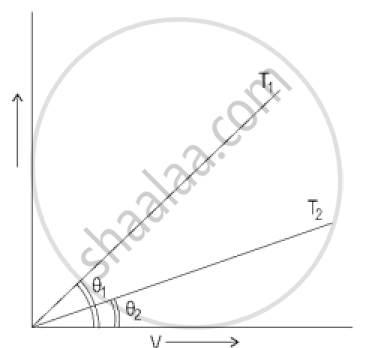Advertisements
Advertisements
Question
In a series LCR circuit connected to an ac source of variable frequency and voltage ν = vm sin ωt, draw a plot showing the variation of current (I) with angular frequency (ω) for two different values of resistance R1 and R2 (R1 > R2). Write the condition under which the phenomenon of resonance occurs. For which value of the resistance out of the two curves, a sharper resonance is produced? Define Q-factor of the circuit and give its significance.
Solution
Figure shows the variation of im with ω in a LCR series circuit for two values of Resistance R1 and R2 (R1 > R2),

The condition for resonance in the LCR circuit is, `ω_0 = 1/(sqrtLC)`
We see that the current amplitude is maximum at the resonant frequency ω. Since im = vm / R at resonance, the current amplitude for case R2 is sharper to that for case R1.
Quality factor or simply the Q-factor of a resonant LCR circuit is defined as the ratio of voltage drop across the capacitor (or inductor) to that of applied voltage.
It is given by `Q = 1/RsqrtL/C`
The Q factor determines the sharpness of the resonance curve and if the resonance is less sharp, not only is the maximum current less, the circuit is close to the resonance for a larger range Δω of frequencies and the tuning of the circuit will not be good. So, less sharp the resonance, less is the selectivity of the circuit while higher is the Q, sharper is the resonance curve and lesser will be the loss in energy of the circuit.
APPEARS IN
RELATED QUESTIONS
Can a hot-wire ammeter be used to measure a direct current of constant value? Do we have to change the graduations?
An alternating current is given by i = i1 cos ωt + i2 sin ωt. The rms current is given by
A constant current of 2.8 A exists in a resistor. The rms current is
A coil of inductance 5.0 mH and negligible resistance is connected to the oscillator of the previous problem. Find the peak currents in the circuit for ω = 100 s−1, 500 s−1, 1000 s−1.
Answer the following question.
A small town with a demand of 1200 kW of electric power at 220 V is situated 20 km away from an electric plant generating power at 440 V. The resistance of the two wirelines carrying power is 0.5 Ω per km. The town gets the power from the line through a 4000-220 V step-down transformer at a sub-station in the town. Estimate the line power loss in the form of heat.
The peak voltage of an ac supply is 300 V. What is the rms voltage?
A small town with a demand of 800 kW of electric power at 220 V is situated 15 km away from an electric plant generating power at 440 V. The resistance of the two wire line carrying power is 0.5 Ω per km. The town gets power from the line through a 4000-220 V step-down transformer at a sub-station in the town.
(a) Estimate the line power loss in the form of heat.
(b) How much power must the plant supply, assuming there is negligible power loss due to leakage?
(c) Characterise the step up transformer at the plant.
Phase diffn between voltage and current in a capacitor in A.C Circuit is.
In the Figure below, the current-voltage graphs for a conductor are given at two different temperatures, T1 and T2.

- At which temperature T1 or T2 is the resistance higher?
- Which temperature (T1 or T2) is higher?
